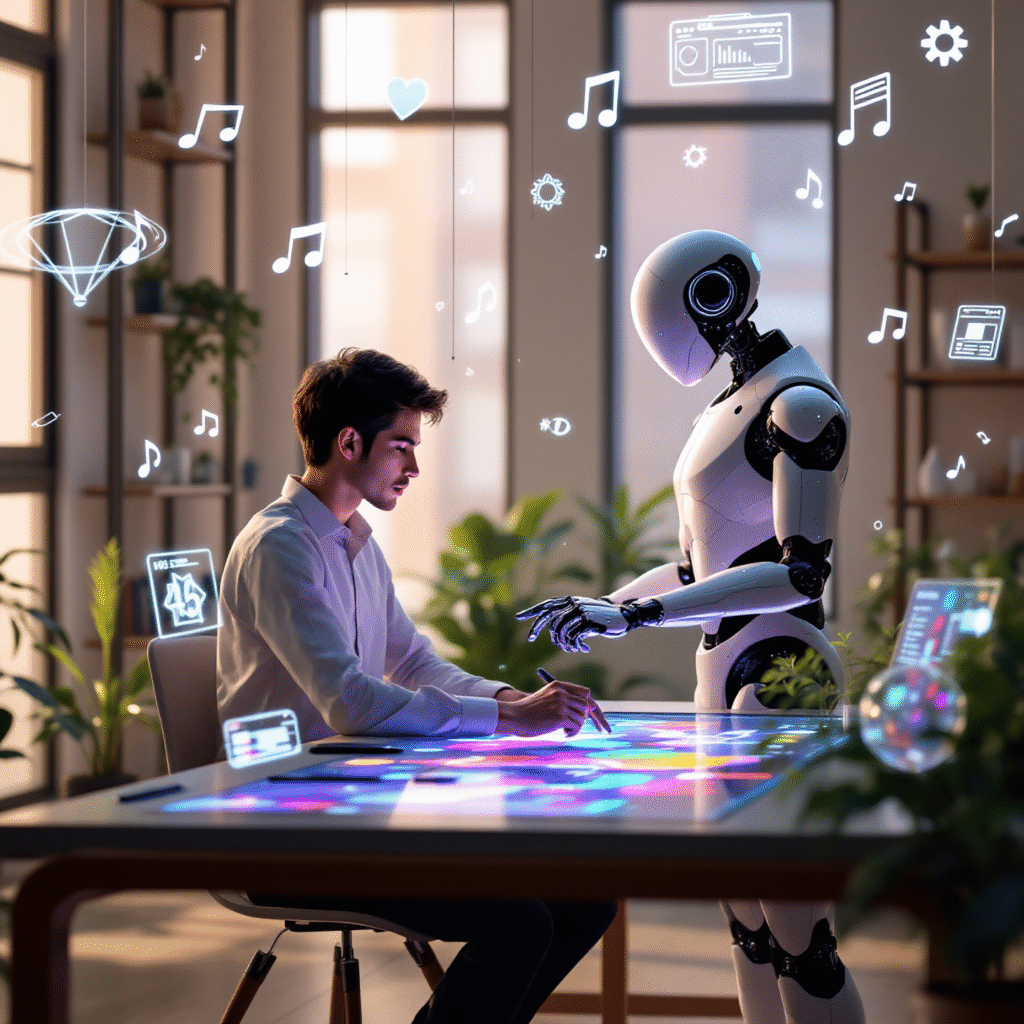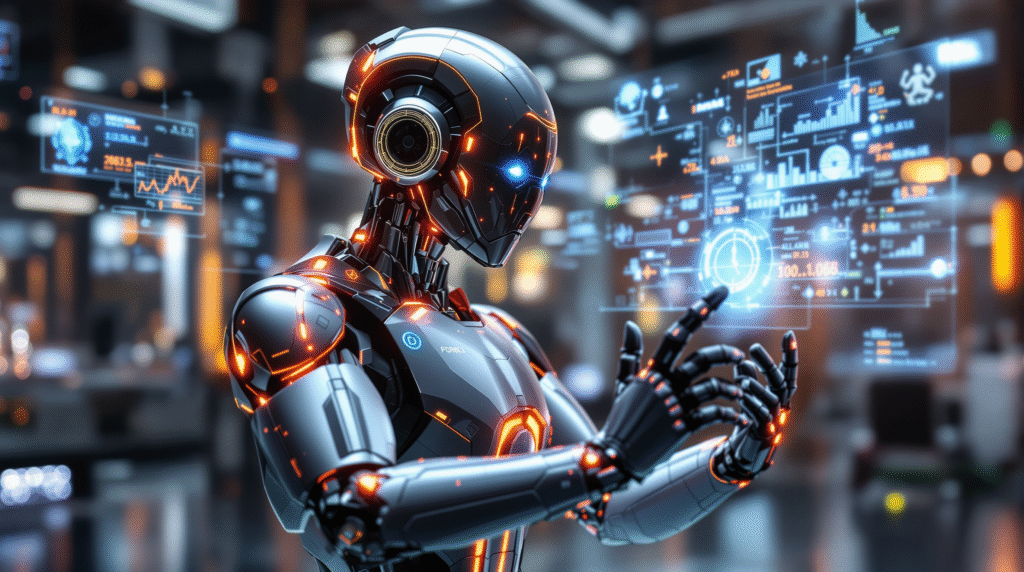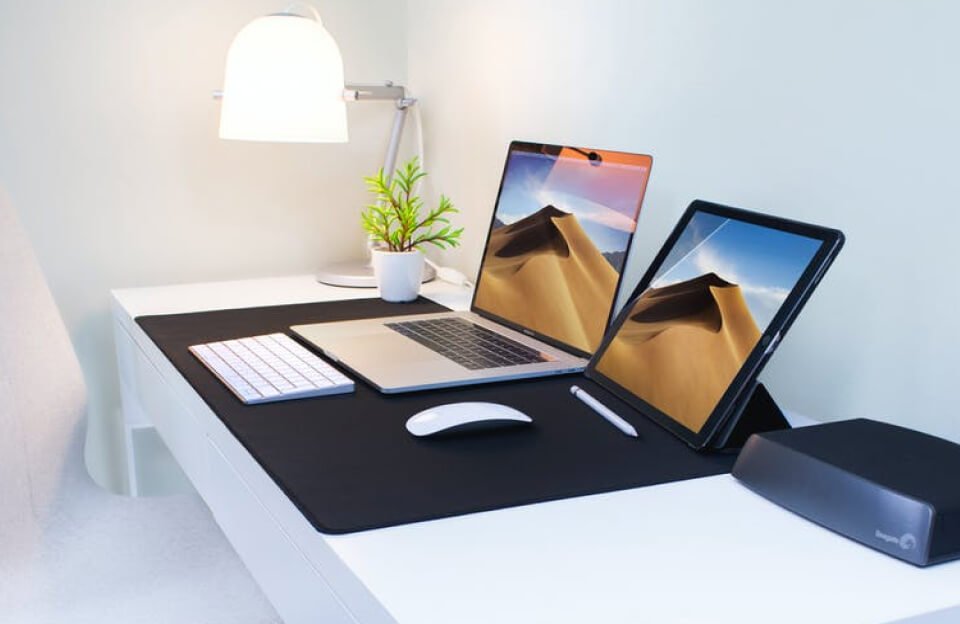Introduction: The New Era of Human-AI Collaboration
For centuries, creativity has been seen as a uniquely human trait—a spark of ingenuity that sets us apart. But as artificial intelligence continues to advance, a new era is dawning: one where humans and AI agents collaborate as creative partners.
This isn’t about replacing human artists, musicians, or designers. Instead, it’s about augmenting their abilities, unlocking new possibilities, and pushing the boundaries of what’s creatively achievable. AI agents can analyze vast datasets, generate novel ideas, automate repetitive tasks, and provide instant feedback—freeing up human creators to focus on the big picture, explore uncharted territories, and bring their unique vision to life.
The collaboration between humans and AI agents is already transforming industries. In music, AI can compose melodies, harmonize vocals, and even generate entire tracks based on a few initial parameters. In visual arts, AI can create stunning images, enhance photographs, and assist in the design process. In writing, AI can help brainstorm ideas, refine prose, and even generate different versions of a story.
This new era of human-AI collaboration is not just about efficiency or automation—it’s about synergy. By combining human intuition, emotion, and experience with the analytical power and creative potential of AI, we can unlock new levels of innovation and artistry.
As we explore the world of creative AI agents, you’ll discover how these technologies are reshaping the creative landscape—and how you can harness their power to become a more effective, inspired, and innovative creator.
What Are Creative AI Agents? Definitions and Capabilities
Creative AI agents are intelligent systems designed to support, enhance, or even initiate creative processes alongside humans. Unlike traditional AI, which often focuses on solving well-defined problems or automating routine tasks, creative AI agents are built to generate new ideas, explore unconventional solutions, and collaborate in open-ended, imaginative domains.
At their core, creative AI agents combine several advanced technologies. They use machine learning to recognize patterns and generate content, natural language processing to understand and produce text, and generative models—such as GANs (Generative Adversarial Networks) or large language models—to create original works in art, music, design, and writing. Some agents can even learn from user feedback, adapting their style or output to better match human preferences.
A key capability of creative AI agents is their ability to work interactively with humans. For example, an artist might use an AI agent to suggest color palettes or generate visual motifs, while a writer could rely on an AI co-author to brainstorm plot twists or refine dialogue. In music, AI agents can propose harmonies, rhythms, or even entire compositions based on a musician’s input.
What sets creative AI agents apart is their openness to experimentation. They can quickly generate multiple variations, explore unexpected directions, and help humans break free from creative blocks. Importantly, these agents are not meant to replace human creativity, but to amplify it—acting as collaborators that inspire, challenge, and support the creative process.
In summary, creative AI agents are intelligent, adaptive partners that bring computational power and fresh perspectives to creative work. By understanding their definitions and capabilities, creators can unlock new ways to innovate and express themselves in collaboration with AI.
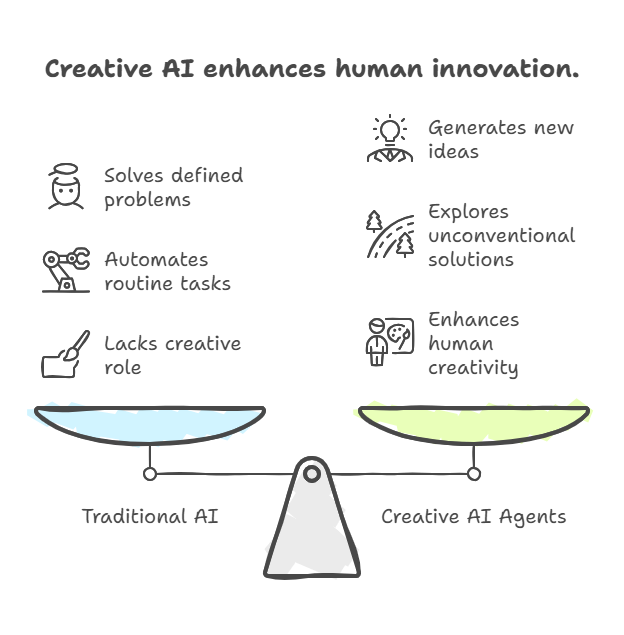
The Evolution of Creativity: From Human-Only to Human-AI Teams
Creativity has always been at the heart of human progress. For centuries, artists, writers, musicians, and inventors relied solely on their own imagination, intuition, and experience to create new works and solve complex problems. The creative process was deeply personal and often seen as something that could not be replicated or assisted by machines.
However, the digital revolution began to change this landscape. The introduction of computers and software tools gave creators new ways to experiment, visualize, and produce their ideas. Yet, these tools were still just that—tools, requiring direct human control and input at every step.
The real shift began with the rise of artificial intelligence. Early AI systems could automate repetitive tasks or analyze large datasets, but they lacked the ability to contribute meaningfully to creative work. That changed with the development of machine learning, deep learning, and generative models. Suddenly, AI could not only process information but also generate new content—images, music, text, and more.
Today, we are witnessing the emergence of true human-AI creative teams. AI agents can suggest novel ideas, remix existing works, and even co-create with humans in real time. For example, a designer might use an AI agent to generate dozens of logo concepts in minutes, or a musician might collaborate with an AI to compose a unique melody. These agents can analyze trends, learn from feedback, and adapt their output to match the creator’s vision.
This evolution is not about replacing human creativity, but about expanding its possibilities. Human-AI teams combine the best of both worlds: the intuition, emotion, and context-awareness of people with the speed, pattern recognition, and generative power of AI. The result is a new era of creativity—one where boundaries are pushed, new forms of expression emerge, and innovation happens faster than ever before.
As we move forward, the collaboration between humans and AI agents will continue to redefine what’s possible in art, design, music, and beyond. The creative process is no longer a solo journey, but a partnership—one that promises to unlock entirely new realms of imagination and achievement.
How AI Agents Enhance Human Creativity
AI agents don’t replace human creativity—they amplify it. By handling routine tasks, generating fresh ideas, and providing instant feedback, these intelligent partners free up creators to focus on what they do best: bringing vision, emotion, and meaning to their work.
Idea Generation and Brainstorming
One of the most powerful ways AI agents enhance creativity is through idea generation. They can analyze vast amounts of data, identify patterns, and suggest concepts that humans might not have considered. This is particularly valuable when facing creative blocks or exploring new directions.
Rapid Prototyping and Iteration
AI agents excel at quickly generating multiple variations of an idea, allowing creators to explore different possibilities without spending hours on each iteration. This rapid prototyping accelerates the creative process and helps identify the most promising directions.
Pattern Recognition and Inspiration
By analyzing existing works across different domains, AI agents can identify trends, styles, and techniques that can inspire new creations. They can suggest combinations that might not be immediately obvious to human creators.
Personalized Assistance
Advanced AI agents learn from individual creators’ preferences and styles, providing increasingly personalized suggestions and assistance over time.
Here’s a practical Python example demonstrating how AI agents can enhance creative writing:
python
import random
import re
from collections import defaultdict
import json
class CreativeWritingAgent:
"""
An AI agent that assists writers with creative tasks
"""
def __init__(self):
self.word_associations = defaultdict(list)
self.story_templates = []
self.character_traits = []
self.plot_devices = []
self._initialize_creative_database()
def _initialize_creative_database(self):
"""Initialize the agent's creative knowledge base"""
# Word associations for inspiration
self.word_associations = {
'mystery': ['shadow', 'whisper', 'secret', 'hidden', 'enigma', 'clue'],
'adventure': ['journey', 'quest', 'discovery', 'courage', 'unknown', 'treasure'],
'romance': ['heart', 'passion', 'tender', 'embrace', 'destiny', 'soul'],
'fantasy': ['magic', 'dragon', 'enchanted', 'realm', 'spell', 'prophecy'],
'sci-fi': ['future', 'technology', 'space', 'alien', 'quantum', 'cybernetic']
}
# Story structure templates
self.story_templates = [
"A {character} discovers {object} that leads to {conflict}",
"In a world where {setting}, {character} must {goal} to save {stakes}",
"When {event} happens, {character} learns that {revelation}",
"A {character} with {trait} encounters {obstacle} and must choose between {choice1} and {choice2}"
]
# Character traits for development
self.character_traits = [
'brave but reckless', 'wise but lonely', 'kind but naive',
'ambitious but ruthless', 'talented but insecure', 'loyal but stubborn'
]
# Plot devices and techniques
self.plot_devices = [
'unexpected ally', 'hidden identity', 'moral dilemma', 'race against time',
'false victory', 'mentor\'s sacrifice', 'power of friendship', 'inner strength'
]
def generate_story_prompt(self, genre=None):
"""Generate a creative story prompt based on genre"""
if genre and genre.lower() in self.word_associations:
theme_words = self.word_associations[genre.lower()]
else:
# Mix words from different genres for unique combinations
all_words = []
for words in self.word_associations.values():
all_words.extend(words)
theme_words = random.sample(all_words, 3)
template = random.choice(self.story_templates)
# Fill template with creative elements
prompt_elements = {
'character': random.choice(['young inventor', 'mysterious stranger', 'retired detective', 'ambitious artist']),
'object': random.choice(theme_words),
'conflict': random.choice(['ancient curse', 'corporate conspiracy', 'family secret', 'time paradox']),
'setting': f"everyone has {random.choice(theme_words)}",
'goal': f"find the {random.choice(theme_words)}",
'stakes': random.choice(['their family', 'the city', 'humanity', 'their dreams']),
'event': f"a {random.choice(theme_words)} appears",
'revelation': f"they are connected to {random.choice(theme_words)}",
'trait': random.choice(self.character_traits),
'obstacle': f"a {random.choice(theme_words)} blocks their path",
'choice1': 'power', 'choice2': 'love'
}
# Generate the prompt
try:
prompt = template.format(**prompt_elements)
except KeyError:
# Fallback if template doesn't match elements
prompt = f"Write about a {prompt_elements['character']} who discovers something about {random.choice(theme_words)}"
return prompt
def suggest_character_development(self, character_name):
"""Suggest character development ideas"""
trait = random.choice(self.character_traits)
motivation = random.choice([
'seeking redemption for past mistakes',
'trying to prove themselves worthy',
'protecting someone they love',
'uncovering the truth about their past',
'fulfilling a promise to a mentor'
])
arc = random.choice([
'learns to trust others',
'overcomes their greatest fear',
'discovers hidden strength',
'makes a difficult sacrifice',
'finds their true purpose'
])
return {
'character': character_name,
'trait': trait,
'motivation': motivation,
'character_arc': arc
}
def enhance_dialogue(self, dialogue_text):
"""Suggest improvements for dialogue"""
suggestions = []
# Check for repetitive words
words = re.findall(r'\b\w+\b', dialogue_text.lower())
word_count = defaultdict(int)
for word in words:
word_count[word] += 1
repeated_words = [word for word, count in word_count.items() if count > 2 and len(word) > 3]
if repeated_words:
suggestions.append(f"Consider varying these repeated words: {', '.join(repeated_words)}")
# Suggest emotional depth
if '!' not in dialogue_text and '?' not in dialogue_text:
suggestions.append("Add more emotional variety with questions or exclamations")
# Suggest subtext
suggestions.append("Consider what the character isn't saying directly")
return suggestions
def collaborative_writing_session(self, user_input, session_context=None):
"""Interactive writing collaboration"""
if session_context is None:
session_context = {'genre': None, 'characters': [], 'plot_points': []}
response = {
'suggestions': [],
'questions': [],
'next_steps': []
}
# Analyze user input for genre and elements
user_lower = user_input.lower()
for genre, words in self.word_associations.items():
if any(word in user_lower for word in words):
if session_context['genre'] != genre:
session_context['genre'] = genre
response['suggestions'].append(f"I sense a {genre} theme. Here are some related concepts: {', '.join(random.sample(words, 3))}")
# Suggest plot development
if 'what happens next' in user_lower or 'stuck' in user_lower:
plot_device = random.choice(self.plot_devices)
response['suggestions'].append(f"Try introducing: {plot_device}")
# Ask engaging questions
response['questions'] = [
"What is your character's biggest fear?",
"What secret is someone hiding?",
"What would your character never expect to happen?"
]
# Suggest next steps
response['next_steps'] = [
"Develop a scene that reveals character motivation",
"Add a moment of conflict or tension",
"Introduce an unexpected element"
]
return response, session_context
# Example usage demonstrating creative enhancement
def demonstrate_creative_enhancement():
"""Show how AI agents enhance human creativity"""
agent = CreativeWritingAgent()
print("=== Creative Writing AI Agent Demo ===\n")
# 1. Generate story prompts
print("1. Story Prompt Generation:")
for genre in ['mystery', 'fantasy', 'sci-fi']:
prompt = agent.generate_story_prompt(genre)
print(f" {genre.title()}: {prompt}")
print()
# 2. Character development
print("2. Character Development Suggestions:")
character_dev = agent.suggest_character_development("Elena")
for key, value in character_dev.items():
print(f" {key.replace('_', ' ').title()}: {value}")
print()
# 3. Dialogue enhancement
print("3. Dialogue Enhancement:")
sample_dialogue = "I think we should go. I think it's dangerous. What do you think?"
suggestions = agent.enhance_dialogue(sample_dialogue)
print(f" Original: '{sample_dialogue}'")
print(" Suggestions:")
for suggestion in suggestions:
print(f" - {suggestion}")
print()
# 4. Collaborative session
print("4. Collaborative Writing Session:")
user_input = "I'm writing about a detective who finds a mysterious letter"
response, context = agent.collaborative_writing_session(user_input)
print(f" User: {user_input}")
print(" AI Agent Response:")
print(" Suggestions:")
for suggestion in response['suggestions']:
print(f" - {suggestion}")
print(" Questions to consider:")
for question in response['questions'][:2]: # Show first 2 questions
print(f" - {question}")
print("\n=== Creative Enhancement Complete ===")
# Run the demonstration
if __name__ == "__main__":
demonstrate_creative_enhancement()
# Created/Modified files during execution:
print("creative_writing_session.json") # Would store session dataThis example demonstrates how AI agents enhance human creativity by:
Generating diverse story prompts to overcome writer’s block
Suggesting character development with traits, motivations, and arcs
Analyzing and improving dialogue with specific suggestions
Providing interactive collaboration through questions and ideas
Real-World Examples: Creative Partnerships in Art, Music, and Design
The collaboration between humans and AI agents is no longer just a futuristic vision—it’s happening right now, across creative industries worldwide. These partnerships are producing remarkable results, blending human intuition and emotion with the analytical and generative power of AI.
Art:
AI agents are increasingly present in the world of visual arts. Artists use generative models like DALL-E or Midjourney to create unique images, illustrations, and even entire exhibitions. For example, the artist Refik Anadol collaborates with AI to transform massive datasets into mesmerizing digital installations, turning raw information into immersive visual experiences. In other cases, painters and illustrators use AI to suggest color palettes, generate backgrounds, or remix their own works, sparking new ideas and directions.
Music:
In music, AI agents are co-composers, arrangers, and even performers. Tools like AIVA, Amper Music, and Google’s Magenta allow musicians to generate melodies, harmonies, and rhythms based on a few simple inputs. The British singer-songwriter Taryn Southern famously released an album co-written with AI, demonstrating how technology can inspire new sounds and creative processes. Producers use AI to analyze trends, suggest chord progressions, or even master tracks, making the music creation process more accessible and experimental.
Design:
Designers are leveraging AI agents to streamline workflows and boost creativity. In graphic design, AI can generate logo concepts, adapt layouts for different platforms, or suggest typography pairings. In architecture, AI-driven tools help visualize structures, optimize space, and even propose innovative building forms. Fashion designers use AI to predict trends, generate fabric patterns, and personalize collections for individual clients.
Collaborative Platforms:
Platforms like RunwayML and Adobe Firefly are making it easier for creators of all backgrounds to experiment with AI. These tools allow artists, musicians, and designers to interact with AI agents in real time, blending their own ideas with machine-generated suggestions. The result is a more dynamic, iterative, and collaborative creative process.
The Human Touch:
What unites all these examples is the synergy between human and machine. AI agents provide inspiration, automate tedious tasks, and open up new creative possibilities—but it’s the human creator who guides the vision, makes the final choices, and infuses the work with meaning and emotion.
As these partnerships continue to evolve, we can expect even more groundbreaking projects at the intersection of art, music, and design. The future of creativity is not about humans versus machines, but about what we can achieve together.
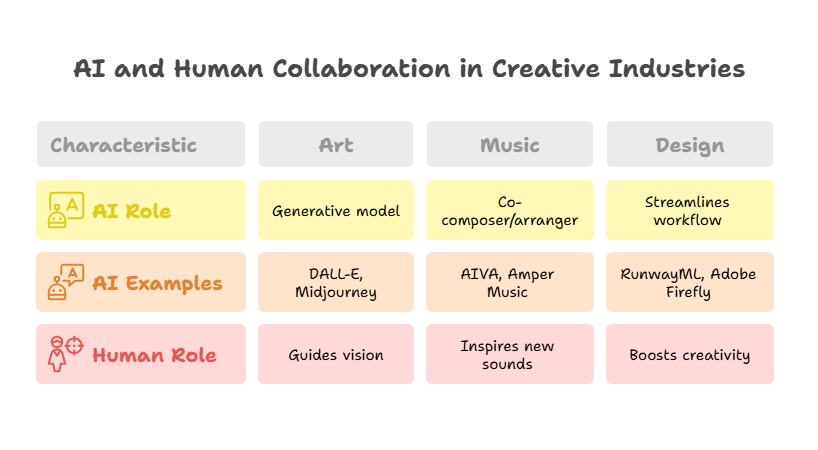
Tools and Technologies for Building Creative AI Agents
The rapid growth of creative AI is fueled by a diverse ecosystem of tools and technologies that empower both developers and artists to build, train, and deploy intelligent agents. Whether you’re a programmer, designer, musician, or visual artist, there are solutions tailored to your needs and skill level.
Machine Learning Frameworks
At the core of most creative AI agents are machine learning frameworks such as TensorFlow, PyTorch, and Keras. These libraries provide the building blocks for training neural networks, including generative models like GANs (Generative Adversarial Networks) and VAEs (Variational Autoencoders). They are widely used for tasks like image generation, style transfer, and music composition.
Generative AI Platforms
Platforms like OpenAI’s DALL-E, Midjourney, and Stable Diffusion have revolutionized the creation of visual art. These tools allow users to generate high-quality images from text prompts, remix existing artwork, or explore new visual styles. In music, tools like AIVA, Amper Music, and Google Magenta enable the generation of melodies, harmonies, and even full compositions with minimal input.
Creative Coding Environments
For those who want to experiment interactively, environments like Processing, p5.js, and RunwayML make it easy to blend code, art, and AI. These platforms are designed for rapid prototyping and creative exploration, often with visual interfaces that lower the barrier to entry for non-programmers.
Natural Language Processing (NLP) Libraries
Text-based creativity is powered by NLP libraries such as Hugging Face Transformers, spaCy, and GPT-based APIs. These tools enable AI agents to generate stories, poetry, dialogue, and even assist with brainstorming or editing.
Collaboration and Deployment Tools
Cloud platforms like Google Colab and Kaggle provide free or low-cost access to powerful GPUs, making it easier to train and test creative models. For deployment, services like Hugging Face Spaces, Streamlit, and Gradio allow creators to share interactive AI-powered applications with the world.
Integration with Creative Software
Major creative software suites are also embracing AI. Adobe’s Creative Cloud now features AI-powered tools for image enhancement, content-aware editing, and generative design. Platforms like Figma and Canva are integrating AI agents to suggest layouts, color schemes, and design elements.
Open-Source Resources and Communities
The creative AI community is vibrant and collaborative. Open-source projects, shared datasets, and online forums (like GitHub, Hugging Face Hub, and Discord groups) provide inspiration, support, and resources for anyone interested in building creative AI agents.
Summary
With this rich toolkit, the only real limit is your imagination. Whether you want to generate art, compose music, write stories, or design new products, today’s tools and technologies make it possible to collaborate with AI agents and bring your creative visions to life.
Best Practices for Effective Human-AI Collaboration
The most successful creative projects involving AI agents are those where humans and machines work together seamlessly, each contributing their unique strengths. To unlock the full potential of these partnerships, it’s important to follow a set of best practices that foster trust, creativity, and productive collaboration.
1. Define Clear Roles and Expectations
Start by clarifying what the AI agent is responsible for and where human judgment is essential. AI can generate ideas, automate repetitive tasks, or provide suggestions, but the human partner should always guide the vision, make final decisions, and infuse the work with meaning.
2. Encourage Iteration and Experimentation
Treat the creative process as a dialogue between human and AI. Don’t expect perfect results on the first try—use the agent’s output as a starting point, iterate, and refine. Experiment with different prompts, parameters, or data sources to discover unexpected directions.
3. Prioritize Transparency and Explainability
Choose tools and models that offer insight into how decisions are made. Understanding why an AI agent suggests a particular idea or solution helps build trust and allows creators to make informed choices. If possible, use systems that provide explanations or allow you to adjust their behavior.
4. Maintain Human Oversight
Always keep a human in the loop, especially when the creative output will be shared publicly or used in sensitive contexts. Review, edit, and curate the AI’s contributions to ensure they align with your goals, values, and standards.
5. Foster Open Communication and Feedback
Treat the AI agent as a creative partner—provide feedback, adjust its parameters, and let it learn from your preferences. Many modern AI tools can adapt over time, becoming more attuned to your style and needs.
6. Respect Ethical and Legal Boundaries
Be mindful of copyright, data privacy, and ethical considerations. Ensure that the data used to train AI agents is sourced responsibly, and that the generated content does not infringe on others’ rights or propagate harmful biases.
7. Embrace Diversity and Inclusion
AI agents can help surface ideas and perspectives you might not have considered. Use them to explore diverse styles, genres, and cultural influences, but always approach the results with sensitivity and respect.
Summary
Effective human-AI collaboration is about synergy, not substitution. By combining the analytical power and generative capabilities of AI agents with human intuition, emotion, and critical thinking, you can achieve creative results that neither could accomplish alone. The best outcomes come from a partnership built on trust, curiosity, and a willingness to explore new creative frontiers together.
Challenges and Ethical Considerations
As human-AI creative partnerships become more common, they bring not only exciting opportunities but also a range of challenges and ethical questions. Addressing these issues is essential for building trust, ensuring fairness, and fostering responsible innovation.
Bias and Fairness
AI agents learn from data, and if that data contains biases—whether cultural, gender-based, or otherwise—the AI’s output can unintentionally reinforce stereotypes or exclude certain perspectives. For example, an AI trained on a narrow set of artworks might overlook diverse styles or cultural influences. To counteract this, it’s important to use diverse, representative datasets and regularly audit AI outputs for bias.
Transparency and Explainability
Creative AI agents often operate as “black boxes,” making it difficult to understand how they arrive at certain suggestions or creations. This lack of transparency can undermine trust, especially when AI-generated content is used in public or commercial settings. Whenever possible, choose tools that offer explainability features or allow users to trace the decision-making process.
Intellectual Property and Copyright
Who owns a work co-created by a human and an AI agent? This question is still being debated in legal and creative circles. Some jurisdictions do not recognize AI as a creator, while others allow for shared or derivative ownership. It’s crucial to clarify rights and permissions before publishing or commercializing AI-assisted works, and to respect the intellectual property of others when training or using AI models.
Authenticity and Attribution
As AI-generated content becomes more sophisticated, distinguishing between human and machine-made works can be challenging. This raises questions about authenticity and proper attribution. Creators should be transparent about the role of AI in their work and give credit where it’s due, both to human collaborators and to the AI tools or datasets used.
Privacy and Data Security
Creative AI agents sometimes require access to personal or sensitive data, especially when personalizing content. Protecting user privacy and securing data against misuse or breaches is a fundamental responsibility. Always follow best practices for data anonymization, encryption, and access control.
Over-Reliance and Loss of Human Touch
While AI can enhance creativity, there’s a risk of becoming overly dependent on automated suggestions, leading to homogenized or less meaningful work. It’s important to maintain a balance, using AI as a tool for inspiration and support, not as a replacement for human intuition, emotion, and originality.
Summary
Navigating the challenges and ethical considerations of human-AI collaboration requires vigilance, transparency, and a commitment to responsible innovation. By proactively addressing these issues, creators can harness the power of AI agents while upholding the values of fairness, authenticity, and respect for both people and technology.
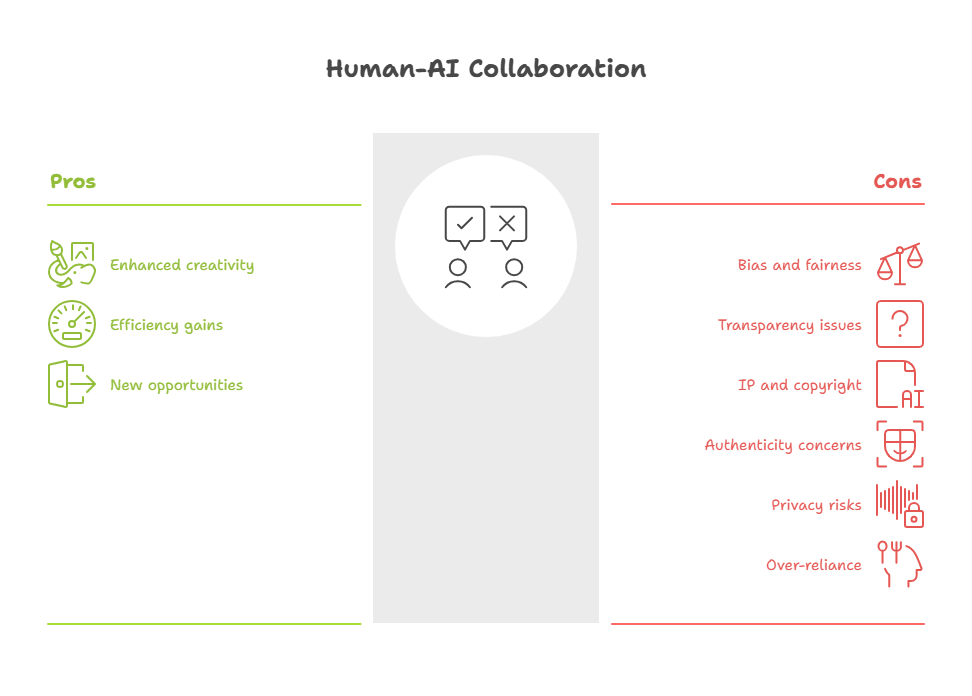
The Future of Creative Work: Trends and Predictions
The creative landscape is on the brink of a profound transformation, driven by the rapid evolution of AI agents and their integration into artistic, musical, and design processes. Looking ahead, several key trends and predictions are shaping the future of creative work.
Deeper Human-AI Synergy
The next generation of creative AI agents will be more collaborative, intuitive, and responsive. Instead of simply generating content on demand, they’ll act as true creative partners—learning from individual preferences, adapting to unique styles, and even anticipating the needs of their human collaborators. This will lead to more fluid, interactive, and personalized creative workflows.
Multi-Modal and Cross-Disciplinary Creation
AI agents are increasingly capable of working across multiple domains—combining text, images, audio, and video in ways that were previously unimaginable. Future creative projects will blend disciplines, with AI agents helping to orchestrate complex, multi-modal experiences that engage audiences on new sensory levels.
Democratization of Creativity
As AI-powered tools become more accessible and user-friendly, creative expression will no longer be limited to those with specialized training or resources. Low-code and no-code platforms will empower anyone to experiment with art, music, and design, lowering barriers and fostering a more inclusive creative community.
Ethical and Authenticity Challenges
With the rise of AI-generated content, questions about authenticity, ownership, and ethical use will become even more pressing. The creative industries will need to develop new standards for attribution, transparency, and responsible use of AI, ensuring that human creativity remains at the center of the process.
Emergence of New Art Forms
AI agents will inspire entirely new genres and forms of creative expression. We’ll see the rise of interactive art installations, generative music performances, and collaborative storytelling experiences that blur the line between creator and audience. These innovations will expand the very definition of what it means to be creative.
Continuous Learning and Evolution
Creative AI agents will become lifelong learners, continuously updating their knowledge and skills based on new data, feedback, and trends. This will enable them to stay relevant, offer fresh inspiration, and support creators in navigating an ever-changing cultural landscape.
Summary
The future of creative work is bright, dynamic, and full of possibility. As AI agents become more sophisticated and integrated into the creative process, they will not replace human imagination—but rather, amplify it. By embracing these trends and remaining mindful of ethical considerations, creators and technologists alike can shape a future where human and AI creativity thrive together, opening doors to new realms of artistic achievement.
Conclusion: Embracing AI as a Creative Partner
The journey through the world of human-AI creative collaboration reveals a simple truth: the most powerful innovations happen when technology and human imagination work hand in hand. AI agents are not here to replace artists, musicians, or designers—they are here to inspire, support, and amplify what makes human creativity so unique.
By embracing AI as a creative partner, we open ourselves to new ways of thinking, experimenting, and expressing ideas. AI agents can generate fresh concepts, automate tedious tasks, and help us see patterns or possibilities we might have missed. Yet, it is the human touch—intuition, emotion, and personal vision—that gives creative work its depth and meaning.
The future of creativity is not about choosing between human and machine, but about building partnerships where each brings out the best in the other. As AI tools become more accessible and sophisticated, creators of all backgrounds will have the opportunity to explore new forms of art, music, and design—often in ways that were unimaginable just a few years ago.
Of course, this new era brings challenges: questions of ethics, authenticity, and ownership must be addressed thoughtfully and transparently. But with responsible innovation and a spirit of curiosity, these challenges can be transformed into opportunities for growth and discovery.
In summary, AI agents are poised to become essential collaborators in the creative process. By welcoming them as partners, we can push the boundaries of what’s possible, create more inclusive and diverse works, and ensure that creativity remains a vibrant, evolving force in our lives. The next masterpiece may not be made by a human or a machine alone—but by both, working together.
AI Agents in Practice: Automating a Programmer’s Daily Tasks
